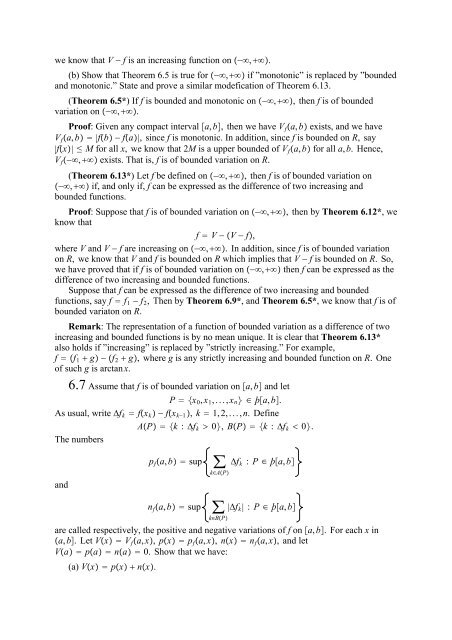The Real And Complex Number Systems
The Real And Complex Number Systems
The Real And Complex Number Systems
Create successful ePaper yourself
Turn your PDF publications into a flip-book with our unique Google optimized e-Paper software.
we know that V f is an increasing function on , .<br />
(b) Show that <strong>The</strong>orem 6.5 is true for , if ”monotonic” is replaced by ”bounded<br />
and monotonic.” State and prove a similar modefication of <strong>The</strong>orem 6.13.<br />
(<strong>The</strong>orem 6.5*) Iff is bounded and monotonic on , , then f is of bounded<br />
variation on , .<br />
Proof: Given any compact interval a, b, then we have V f a, b exists, and we have<br />
V f a, b |fb fa|, sincef is monotonic. In addition, since f is bounded on R, say<br />
|fx| M for all x, we know that 2M is a upper bounded of V f a, b for all a, b. Hence,<br />
V f , exists. That is, f is of bounded variation on R.<br />
(<strong>The</strong>orem 6.13*) Letf be defined on , , then f is of bounded variation on<br />
, if, and only if, f can be expressed as the difference of two increasing and<br />
bounded functions.<br />
Proof: Suppose that f is of bounded variation on , , then by <strong>The</strong>orem 6.12*, we<br />
know that<br />
f V V f,<br />
where V and V f are increasing on , . In addition, since f is of bounded variation<br />
on R, we know that V and f is bounded on R which implies that V f is bounded on R. So,<br />
we have proved that if f is of bounded variation on , then f can be expressed as the<br />
difference of two increasing and bounded functions.<br />
Suppose that f can be expressed as the difference of two increasing and bounded<br />
functions, say f f 1 f 2 , <strong>The</strong>n by <strong>The</strong>orem 6.9*, and<strong>The</strong>orem 6.5*, we know that f is of<br />
bounded variaton on R.<br />
Remark: <strong>The</strong> representation of a function of bounded variation as a difference of two<br />
increasing and bounded functions is by no mean unique. It is clear that <strong>The</strong>orem 6.13*<br />
also holds if ”increasing” is replaced by ”strictly increasing.” For example,<br />
f f 1 g f 2 g, whereg is any strictly increasing and bounded function on R. One<br />
of such g is arctan x.<br />
6.7 Assume that f is of bounded variation on a, b and let<br />
P x 0 , x 1 ,...,x n þa, b.<br />
As usual, write f k fx k fx k1 , k 1,2,...,n. Define<br />
AP k : f k 0, BP k : f k 0.<br />
<strong>The</strong> numbers<br />
and<br />
p f a, b sup<br />
f k : P þa, b<br />
kAP<br />
n f a, b sup<br />
|f k | : P þa, b<br />
kBP<br />
are called respectively, the positive and negative variations of f on a, b. For each x in<br />
a, b. LetVx V f a, x, px p f a, x, nx n f a, x, and let<br />
Va pa na 0. Show that we have:<br />
(a) Vx px nx.
















